Updated: 14-Oct-2020
(see also Devore)
Aerojet Engineering Corp. is an affiliate of General Tire & Rubber and therefore known as Aerojet General Corp.
-Aerojet-General Corp. (Code = AJ) was compartmentalized into Divisions as follows:
-Aerojet Solid Propulsion Co. (ASPC).
-Aerojet Liquid Rocket Co. (ALRC).
-Aerojet Nuclear Systems Co. (ANSC).
-Aerojet Strategic Propulsion Co.
-Aerojet Techsystems Co.
-Aerojet Redmond Co.
-The Aerojet Nuclear Systems, is responsible for the "Nerva" project (see) or Nuclear Engine Rocket for Vehicle Aplication.
-The nuclear part of the work was done by Westinghouse as an Aerojet's subcontractor. The project was canceled in 1972.
-Aerojet Co. Techsystems tested hybrid rocket-turbine engines such as the "Air Turbo ramjets" that were intended for future transportation at Mach 5.
-This Division is responsible for the Aerojet engines AIM-9 Sidewinder, Maverick, Sparrow, Shrike, Skipper, etc., all with HTPB (Polybutadieno) solid fuel.
-Aerojet Redmond is known for its maneuvering engines used in the "Space Shuttle", the OMS maneuvering engines or "Maneuvering Orbiter Systems". They were fully controllable and used exotic fuel like monomethylhydrazine and nitrogen tetroxide.
-As in most of the important companies there are "Joint Ventures" with other companies, thus resulting in the Aerojet / PW for the Cobra engine.

"JATO"
-While aircraft engines did not develop sufficient power for takeoff, as the aircraft became larger each day, the most popular product of Aerojet General was the JATO that is synonym for "Jet Assisted Take Off".
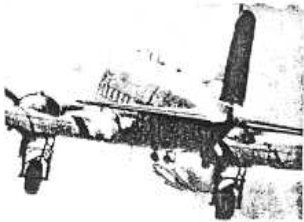
“Jatos in a DC-3”
-(Sometimes known as RATO or "Rocket Assisted Take Off").
-There were numerous variants, as many as there were different aircraft applications.
-The one above is the 15KS1000, one of the most common in shape and characteristics.
-The name meant that it was able to produce a thrust of 1000 lbs. for 15 seconds.
-Although early versions generated a lot of smoke, the latter known as "Smoke-less" hardly produced it.
-In some photographs taken at the NASM museum, we see the first Aerojet JATO engine that was tested by Boushey Hornet.
-It was very small, with solid fuel and was installed in an Ercoupe plane in 1941.
-It was designed at the Guggenheim Aeronautical Laboratory of the California Institute of Technology.
-It gave 12.8 Kgs. of thrust and we can see it has a spark plug for ignition on one side, near the outlet nozzle.
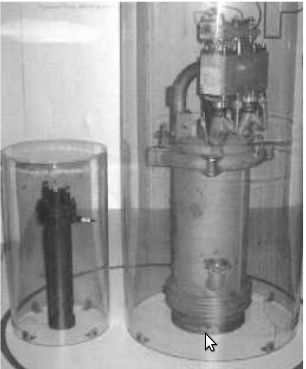
"Two JATO: The first in US and the YLR-AJ-1"
-The greatest on the right is the JATO YLR-AJ-1 that was also built by Aerojet-General Corp., a branch of the General Tire and Rubber Co.
They were used in military aircraft in the 50's like the B-47's and F-86's.
-The engine of the Rocket Nike-Ajax surface-to-air missile used hypergolic propellant, that means self-igniting upon contact of both fuel components.
-It had no moving parts and fuel and oxidant reached the engine deposits because of the compressed air pressure in the tanks.

"Aerojet engine of the Nike-Ajax"
-Another curious engine is the one that was developed by Prof. Dr. Robert Gordon of Aerojet General in 1948, but independently of the company.
-It was a ball of tubes and through these tubes passed hydrogen and oxygen in a gaseous state cooling chamber and nozzle.
It also received the name "Spaghetti"
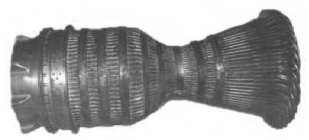
"Gordon's rocket engine"
-The 14AS1000, like all "JATO" used solid fuel and oxidant, usually polybutadiene and NH4-CIO4 as oxidizer or oxidant. It was molded into the cartridge and combustion was maintained above 370oC, but had to start combustion with black powder and an electric igniter.
-The Aerojet 12AS250B, known as the "Junior Rocket" was smaller, about 35 centimeters long, like a bottle (250 lbs. of thrust).
-The range of JATOS began with engines with a short time of operation for special jobs, such as the 1AS-, 2KS-, 2'5KS-, 5AS-, 6'15AS-, 7KS-, 8AS-, etc.
-El 1KS-2 was destined for guided missiles and delivered 2800 lbs of thrust using Aeroplex AK-14 and leaving a dense white fuming.
-The 2KS-11000 was similar to the one mentioned before but much more powerful and with the same propellant, and for the 2KS-33000 the same. As well as for the 2.5KS-18000 of the JATO family that was destined for cruising missiles etc. with a short thrust period until it reaches the lifting speed and the main engine was working.
-The 5AS-1's (1000 lbs) were destined to takeoff aid and used ALT-161 fuel leaving white smoke. The small 6015KS-155A was destined for guided missiles (155 lbs) and it used Aeroplex AK-14.
-To launch Ram-jets the 7KS6000 (T-27) with 6000 lbs of thrust was used. It used Panaplex and left a dense white smoke.
-The 8AS200 JATO's used Galcit 53 and the 8AS500 Galcit 58. The same for the 8AS1000 and the 8AS750, with ALP-1 fuel giving a dense white smoke.
-The 10AS1000A used Galcit 61C just the same as the 14AS1000's (D-4 y D-5) and the30AS1000C's.
-The 15KS1000's were "smokeless".
-In all of them the jet velocity was higher than 1500 meters per second. All "JATO's" were returned to the manufacturer for recharging. They were mounted in various parts of the fuselage, with fixed mounting points to the structure. Some of them could be dropped.
-Aerojet is very important in the space sector, the military and with little luck in the NASA scene until the Apollo project arrived.
-Engines used as missile launch aid, called "Missile Boosters" already had a considerable size and they were considered not to be JATO.
-They also manufactured from the most powerful engines with liquid propellant for the Saturn rockets like the F-1 and later the M-1, to the smallest maneuvering engines for satellites and apogee.
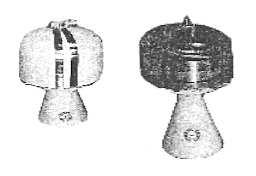
"maneuvering engines"
-We can say that also captured military engines as Regulus missiles, Polaris, Minuteman, Genie, Eagle, Tartar, Skybolt, etc., all with solid fuel, ready at any time and easy to store.
-Some of the Engines known as SR or "Solid Rocket", like the SR-19 were used in second stages, the SR-105, SR-115 in the AGM-65, the SR-116 in the AIM9-J/P (of some Sidewinder), the SR-119 was used in the LGM-118 in the second stage.
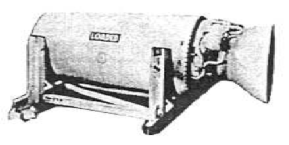
"Solid Aerojet , charged"
The SR were common in a wide range of on board missiles as the Able, Algol, Zebra, Hawk, Alcor, Astrobee, Harpoon, Phoenix, Shrike, Maverick and the famous Sidewinders.
-We emphasize that the SR-73 was a cooperation between Aerojet and thiokol (see).
-The Minuteman, ICBM US defense standard, was easy to use and install and it also used the SR polybutadiene (or Butyl type of rubber) fuel and as oxidant or oxidizer it used NH4-CIO4 (nitric acid) instead of liquid oxygen that was common in LR rockets that needed cryogenic installations and a slow charging process before launching. The Minuteman-2 used the engine named M56A-1.

"Saturn rocket engine"
-The Saturn V rocket motors (Apollo project, led by Werner Von Braun, see) were built by Aerojet under contract from Rockwell.
-To get the engines F-1, J-2 and M-1, Aerojet went through a long experience in design and construction of the LR liquid fuel engines, first as takeoff aid until it got to the engines mentioned before.
-The Aerojet Propulsion Div gave some references to their engines which were equivalent to the US Military Code, having thus:
-LR1-AJ-1 (Aerojet 25AL1000). In the A-20 aircraft and always mounted to the fuselage, with 1000 lbs. of thrust.
-LR3 (25ALD-1000) RATO for the B-25J, F-38 and B-24, could be launched.
-The X35-ALD-6000 began their development in 1942.
-LR5 (X40-ALD-3000) RATO, could be launched. Weight of the propellant 730 lbs.
-LR7 (XCALT-6000), they are 4 engines of 1500 lbs. that can work in pairs giving 3,000/6,000 lbs. fueled by turbine pump and consuming 80% of Aniline and 20% of Furfuryl-alcohol and nitric acid (red smoke).
-LR9 (X4-AL-1000) is used as a brake on gliders. Short performance with only 25 lbs. of Aniline as propellant and nitric acid as oxidant to give 1000 lbs. of thrust.
-The X60-AL-1500, from 1945 to add performances to the P-51.
-The LR13 (X60-ALD-4000) was used to assist with takeoff on B-45 aircraft. They could be dropped with parachutes and used the same fuel as the LR7. Later they were designed to use gasoline and nitric acid (white smoke). In the year 1948.
-All LR engines began with the AJ-1 version, or LR13-AJ-1. The -3 and -5 versions that went on the B-29 could be dropped and were unrecoverable.
-The fuel supply was by pressurized tanks with nitrogen. They gave 4000 pounds of thrust and used Xylidina (70%) AN-F-48, gasoline 20% and nitric acid (red smoke).
-The XLR15-AJ-1 (XCNLT-1500) used single fuel, nitromethane (Isopropylnitrate) with a catalyst for starting.
-It did not result in success and they stopped working on it soon. 1945.
-Without information about the XLR-16 at the moment of writing this chapter.
-The LR20-AJ2 was used in the Lark missile with three stages.
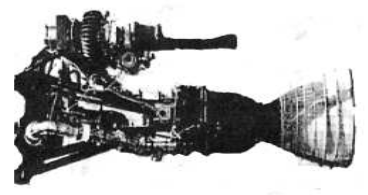
“LR87”
-The LR87 engine is memorable. They were used in Titan rockets and in a dual-engine version for Titan II, III and IV.
-It was the first engine to use multiple fuels (with slight modifications) being the three main combinations, the one of liquid oxygen with RP-1, the combination of storable hydrazina with nitrogen tetroxide and the most powerful combination: liquid oxygen with hydrogen.
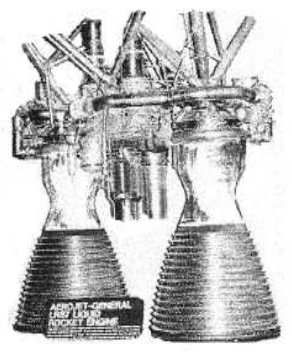
"Dual LR-87 assembly"
-In these tests they attempted to increase the mass of gases using fuel with metallic mixture of higher density, it was the aluminized version as a gel (Carbopol 904) from Aerozine-50 and as oxidant tetroxide hydrogen, both self-igniting or Hypergolic. Fluorine and hydrogen tests were also made.
-The LR87 was similar in concept to the LR99. The initial thrust with a single chamber was 68,000 kgf for 350 seconds in vacuum (59,000 Kgf at sea level).

“Aerojet LR87”
-They were used in the Mercury project as first stage engines. The Titan had a LR-91 in the second stage.
-These engines can be seen in the museums of the Kirtland AFB bases, New Mexico or in the Wright Patterson.
-From the LR73 and the LR113 we do not have relevant information.

"F-1 y J-2"
-The M-1 that gave "somewhat" less power than the F-1 had the typical elongated nozzle to give improved performance in a vacuum.
-The F-1A gives 820,000 Kgf. of thrust with a nozzle diameter of 3.61 meters, while the M-1 gives 680,000 Kgf. with a nozzle diameter of 4.28 meters and a total motor height of 7.72 meters instead of the F-1A's 5.48.
-The J-2 has 90,000 Kgf. of thrust, in the -T-200K version, 113,500 Kgf. in the -T-250K, 114,000 Kgf. in the J-2B, etc.
-They were mainly used in second stages. A derivative of them is the HG-3 with almost 143,000 Kgf of thrust.
-The M-1 was not lucky because the program was designed for the post-Apollo era and was undermined by lack of funds. It was destined for the moon landing towards 1968/9.

"M-1"
-Note the size of a person in the picture above from the NASA Aerojet M-1.
-One important Joint Venture was with Pratt and Whitney for the COBRA engine. This engine used the turbo pumps from the Space Shuttle engine.
-It had 600,000 lbs of thrust in vacuum and used LOX (liquid oxigen) and liquid hidrogen.
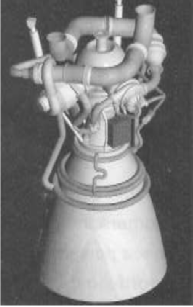
“Aerojet/Pratt & Whitney COBRA”
-Lately Aerojet's organization is very divided by specialties.
-It could be as follows:
-The BMT or Ballistic Missile Technologies, which manufactures rocket motors for missiles, like in the picture below.
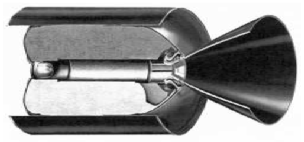
"Solid engine for missile"
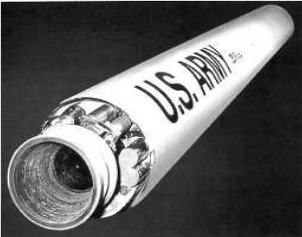
"Solid rocket engine for launcher"
-Division dedicated to "Space Lift Propulsion" that are currently using mainly AJ-10 and AJ-26 engines and their various sub-models.
-Below we show a picture of a NK33-43 that is tested on the bench.
-They operate with liquid fuel, and we can clearly see the tube ends for both liquid components and especially the thick one that is vaporizing because of the cryogenic LOX.
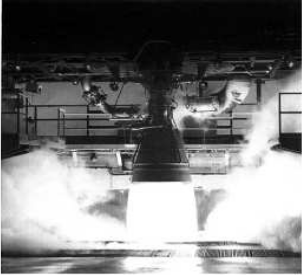
"Testing the NK33-43”
-There is a wide range of bi-propellant, great height engines, as shown by their long nozzles.

"Two bi-propellant engines"

"Another high bi-propellant engine"

"An Aerojet selection"
-The Tacticals Systems Propulsion, is destined to the projects of ATACMS, CKEM, GMLRS, HAWK, Javelin, JCM or LOSAT.
-The Spacecraft Propulsion, with a series of rocket engines using electric propulsion, through the Hall effect. The maneuver thrusters used Hydrazine as a single propellant for the Mars Rover, Discovery, GPS Sat., etc.

"Aerojet thruster"
-The Spacecraft propulsion engines have been used in the Messenger, Mercury, Pluto, Mission Themis, GPS programs, etc.
-The Missile Defense Propulsion engines use liquid and solid fuel.
-For the engines developed by Air Breathing Propulsion, we have ramjets with double combustion chamber or TBCC.
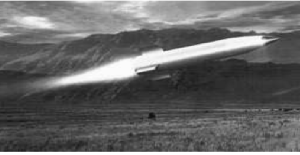
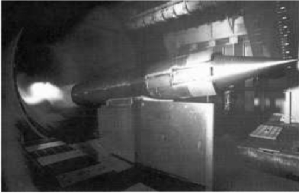
"Dual chamber Ramjet, simulation on the bench"
-The TBCC, also known as "Pyrojet", is a Turbine Based Combined Cycle engine.
-It is a joint project of Pyrodyne and Aerojet.

"Pyrojet diagram"
-An engine that is capable of propelling vehicles from 0 to 10 Mach.
From appendix 6: We begin this expansion with a picture of the LR-91 mentioned in the main text.
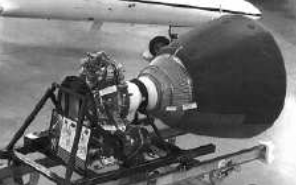
“LR-91”
-And in this new extension of Aerojet we include a better photograph of the LR-87. They served twin mounted for the Titan, etc. Being ICBMs in addition to space carriers, they used hypergolic fuels, which ignited by contact alone.

“LR-87”
-The last ones used Aerozine-50 / nitrogen tetroxide that could be stored at room temperature. Being a design from the year 1956 they delivered 430,000 lbs of thrust but they could not control this thrust nor could they reignite.
-And now a diagram that shows the ratio between the size of the M-1 Saturn engine and a person in scale. It also indicates the area ratio of the normal nozzle and the added one for high altitude.
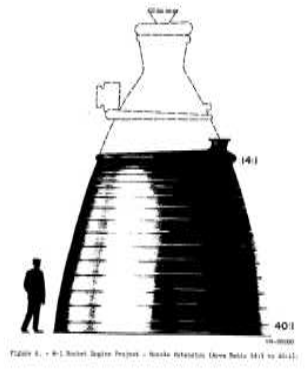
“M-1”
-We located a picture of the Aerojet General LR-AJ-5 at the PIMA Air and Space Museum at Tucson, Arizona.
-This engine gave 100,000 lbs of thrust and was used in the Titan II, III, Titan 34D and Titan IV.
-It has a single chamber using liquid fuels allowing long storage, just like the WS-87, but it was used in the second stage of two stage variants.
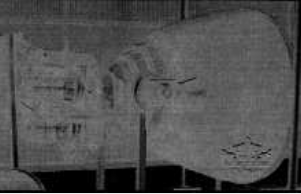
“LR-AJ-5 at the Pima Air and Space Museum” (PiP)
-The picture below shows the cluster of five F-1 engines of the Saturn at Cape Canaveral, Florida.
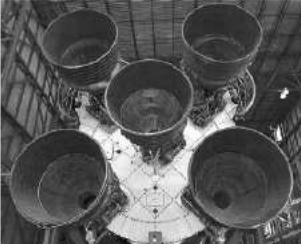
"Saturn, first stage"
-The pictures of two Aerojet engines from the the first era have appeared recently. These engines were used in the Northrop XP-79 prototypes. They are the XCALR-200 and -2000.
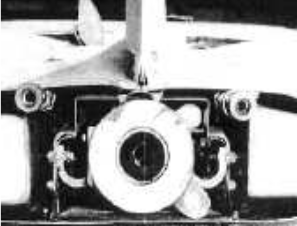
“Aerojet XCALR-200”
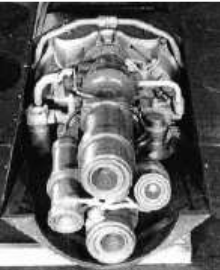
“The XCALR-2000”
-The rocket engine Aerojet-General LR45-AJ-1 was a booster used for takeoff aid in the Boeing B-47E on each side of the fuselage being retractable.
-It has two combustion chambers of 4,500 lbs. each and it uses nitric acid and JP-4 or the plane's own kerosene.
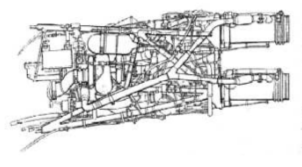
“Aerojet-General LR45-AJ-1”
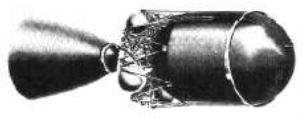
"Aerojet engine for the Delta 3910"
From appendix A2/6: The solid-fuel rocket engine 503NS-35 was the one that was used in the pilotless aircraft, RPV Radio-plane RP-76.
-For the sounding rockets Aerobee 100 and 150, the Aerojet General made the Aerobee 100 engines for the first and Aerobee 150 for the second.
-The Aerobee 100 used liquid fuels such as Aniline and IRFNA as oxidant. When starting, UDMH was introduced.
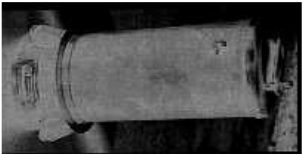
“Aerobee 100” (PiP)
-It gave 2,600 lbs of thrust for 40 seconds. Its factory reference was 45AL-2600 and it was a derivative from a WAC Corporal engine. (See).
-The Aerobee 150 became a classic as from 1947 when it appeared and it was used in hundreds of high altitude vehicles.
-It was called AJ-11-6 and delivered 4,100 lbs for 42 seconds using the same fuel as the Aerobee 100.
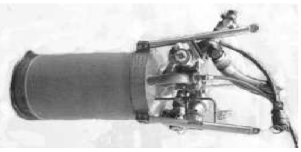
“Aerobee 150”
-Very similar is the YLR45-AJ-1 but with 10,000 lbs of overall thrust. This engine was used in pairs. It was from 1948 and it was used as JATO to assist (booster) the B-47B bomber.
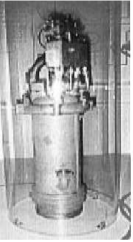
“YLR45-AJ-1”
-In the early 1950's and before the superiority of the MiG-15 against the Sabres in Korea they began to design the LR-63-AJ-1 to be installed not only as JATO but to assist in combat, especially for the climbs where the MiG got lost.
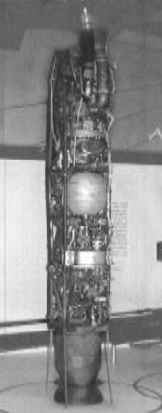
"The Aerojet engine for the Sabre F-86"
-This engine was designed and distributed to go completely streamlined.
-It delivered 3,500-5,000 lbs of thrust, but it was not operational until 1956, after the war.
-The design of the Aerojet 25ALD-1000 was done by GALCIT or Guggenheim Aeronautical Laboratory of the California Institute of Technology (see).
-They were built by Aerojet.
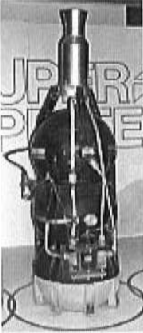
“The 25ALD-1000”
-The first design was the 25AL-1000 and it was used for the first JATO takeoff in 1943. Two of them were mounted on a Douglas Havoc.
-The 25ALD-1000 was already installed in the B-24, B-25, C-40 y P-38.
-It worked with nitric acid (red fuming) and aniline.
-Now a drawing of a turbo-rocket project published by Aerojet.

"Sketch of the 1964 Aerojet"
-This project exists because of William House from Aerojet who investigated these engines between 1949 and 1964.
-A small Junior Jato engine installed on a Ryan Navion airplane, in one of the first tests performed with these engines to make takeoffs shorter, and to free obstacles at higher altitudes.
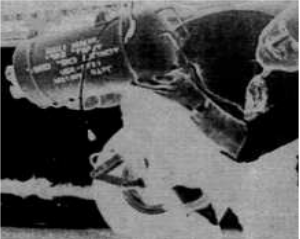
“Aerojet engine in the Ryan Navion” (PiP)
From appendix 7: Aerojet AJ26-58/59 engines were made with Russian NK-33 license.
-And the AJ-26-60 was made with license from the NK-43 that was derived from the NK-33.
-Both types of engines were destined to the K-1 Kistler Aerospace carrier.
-Three NK-33 engines in the first stage with oxygen and kerosene.
-The second stage had a NK-43 with the same fuels.
-These are engines that can be reused many times. They were derived from a Russian space ship that used N-1.
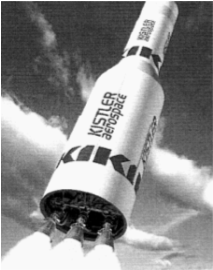
“K-1 rocket with Aerojets”
Appendix 9: This manufacturer of American rocket engines acquired the license to build the Russian NK-33 engine (14D15).
-The NK-33 and its derivative NK-43 received the American designations AJ-26 and AJ-62 respectively for the Antares carrier rocket, and the AJ-58 in 1960 for Kristler. See main text.
-The Russian NK-33 engines were designed for the lunar spacecraft N-1 that failed in its purpose. Therefore, the project was abandoned and the engines too, but 40 years later they have returned to the scene designed by the new SNTK Kuznetsov offices and built by TsSKBas Progress.

“Aerojet AJ-26-62”

“Kuznetsov NK-33”
-From appendix 9. We have received a relationship of rocket engines to make a cross reference and contrast data.
-21AL-2600, 23KS-11000, 25AL-1000, 25XALD-1000, 300LR-200, 30AL-1000, 30KS-8000 (Alcor), 38ALDW-1500, 40ALD-3000, 40XAL-4000, 45AL-2600, 45LR-35000, A1P-1, A1P-2, A2P-1, A3P-1, Aerobee, Aerobee-100, Aerobee-Jr, Aerobee-2, Aerobee-21, Aerobee-445, Aerobee-62, Aerobee-Sr, Aerobee-SRB, Aerotojet (XCALR-2000A-1) Air Turborocket-augmented-, AJ10-101, AJ10-104, AJ10-118, AJ10-118, AJ19-118D, AJ10-118E, AJ10-118F, AJ10-118G, AJ10-118H, AJ10-118J, AJ10-118K,AJ10-131, AJ10-137, AJ10-138, AJ10-190 (OME), AJ10-196 (LR66-AJ-2), AJ10-198, AJ10-24, AJ10-25, AJ10-27, AJ10-28, AJ10-33, AJ10-34, AJ10-40, AJ-10-51, AJ11-21, AJ11-6, AJ23-127, AJ23-130 (LR87-3), AJ-26.
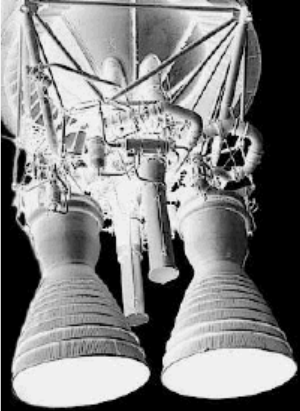
“Aerojet LR-87-3” (PiP)
-AJ23-131 (LR91-3), AJ23-132 (LR-87-5), AJ23-133 (LR91-5), AJ23-134 (LR-87-7), AJ23-135 (LR91-7), AJ23-136 (LR87-9), AJ23-137 (LR91-9), AJ23.138 (LR87-11-138), AJ23-139 (LR87-11), AJ23-140 (LR91-11), AJ23-141, AJ23-142, AJ23-143, AJ23-144, AJ23-145, AJ23-146 (M-1).

“Aerojet M-1”
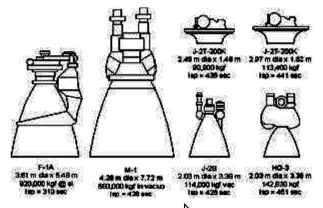
“M-1 proposed for Saturn and Nova”
-AJ23-147, AJ24-1 (YLR-45), AJ-260 1/3, AJ269-2, AJ260-X, AJ260X-1/3, AJ260-62 (base NK-33, ver AJ-26), AJ60-91, AJ60-92, AJ60C, Alcor-1B, Ares, Astrobee D, Astrobee F, Centrojet.

“Aerojet AJ260-2”
-Hustler “APU”, Hydac, Javelin 3, JIC, LH2-2000, LH2-3000, LR-49, LR-51, LR-52-AJ-1, LR-59-AJ-1 (45LR35000), LR-73, LR-73-AJ-1, LR-87, LR87-LH2, LR87+, LR87-11, LR-11-138, LR-87-3, LR87-5, LR-87-7, LR-87-9, LR-91-11, LR-91-3, LR-91-5, LR-91-7, LR-91-9.
-M-1, M56A-1, Orion, Sea Dragon 1, Sea Dragon 2, Senior, SICBM-2, SR-105, SR-115, SR-116, SR-119, SR-19, SR-73, Super Loki, Transtar, Truax LH2, X4-AL-1000, X45-ALD-4000.
-X60-AL-1300, X60-ALD-4000, X90-ALT-60000, XASR-1, XCAL-200 (300LR-200), XCALR-2000A-1, XCALT-600, XCNLT-1500, XCNLT-1000, XCN-LT-1500, XLR-13-AJ-1 (X60-ALD-4000), XLR-13-AJ-3 (X45-ALD-4000), XLR-13-AJ-5, XLR-13-AJ-7.
XLR-15-AJ-1 (XCNLT-1500), XLR-16-AJ-1 (LR-16), XLR-1-AJ-1 (25AL-1000),, XLR-20-AJ-2, XLR-23-AJ-1 (X90-ALT-6000), XLR-24-AJ-2, XLR-3-AJ-1 (25-XALD-1000), XLR-49-AJ-1 (LR-49), XLR-51-AJ-1 (LR-51), XLR-53-AJ-1, XLR-5-AJ-1 (40-ALD-3000), XLR-7-AJ-1 (XCALT-6000), XLR-9-AJ-1 (X4-AL-1000), YLR-45-AJ-1 (Jato), YLR-45-AJ-3, YLR-63-AJ-3.
-From appendix 10: We continue publishing and declassifying rocket-engine information and photographs from USAF and NASA.
-We now have a solid-fuel Jato engine lot (Jet-Assited-Take-Off) for takeoff assistance for heavy aircraft or at high altitude airfields.
-Most solid and liquid rocket engines are used in space flights.

"Jato assortment"
-From top to bottom, we have the:
-2.2KS-33000
-5KS-4500
-2.2KS-11000
-15KS-1000
-14AS-1000
-12AS-250 Junior Jato
-For takeoff and combat assistance. The 1.3 K engine that was tested in the North American P-51 Mustang gave an increase of 100 knots at higher altitudes.
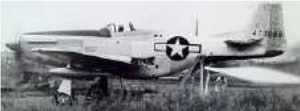
"The beautiful Mustang with booster"
-The same thing happened to the great USAF bomber, the Boeing B-29, that also had JATO engines but with liquid fuel with its deposits in a full "pack". as we can see in the following picture(PiP).
-It has parachutes for recovery.
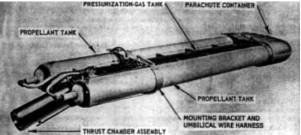
"Aerojet-General LR13-AL-13"
-Below is a list of new Aerojet-General engines photos that are used as boosters in special vehicles.
-The 1.9KS-18100 for the space glider, the shuttle's predecessor"

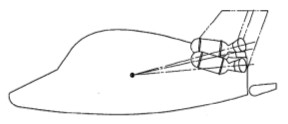
“One of the engines and the NASA spaceplane”
-This granular solid fuel engine had two spark plugs and the nozzle inclined at 28o. The inner space had a star shape.

"2KS-23800 Booster"

"2,5KS-560 separtion engine" (Apollo)
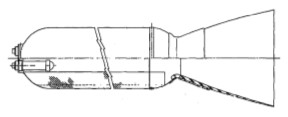
"1KS-23800 escape engine" (Apollo)
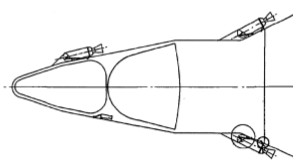
"Apollo escape engines"
-Two escape engine crowns and seperation engine crowns.
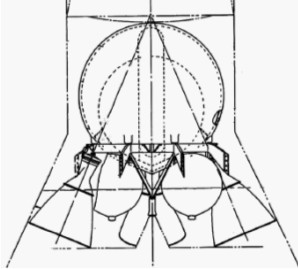
"Four Apollo AJ-10-133 engines"

"The huge Apollo-V M-1 engine"
-The first stage has a cluster of various M-1 engines.

"LR-85"
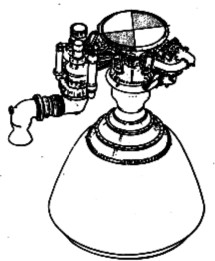
"LR-91, without nozzle"
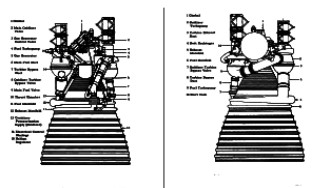
"J-2 front and rear view"
-Curiously, the J-2 appears on Rocketdyne's and Aerojet's manufacturing lists, such as J-2-X. And that is because NAA, Rocketdyne, and Pratt & Wtihney ended all up in the new Aerojet/Rocketdyne group in 2013.
-Therefore, at one time or another, most of these companies' rocket engines are attributed to this brand.
Engines of AEROJET - GENERAL
Model: 10AS1000A
Model: 12AS250B
Model: 14AS1000
Model: 14AS1000 (D-4 y D-5)
Model: 15KS1000
Model: 15KS1000
Model: 1AS
Model: 1KS-2
Model: 25ALD-1000

"The 25ALD-1000"
Model: 2’5KS
Model: 2’5KS-18000
Model: 2KS
Model: 2KS-11000
Model: 2KS-33000
Model: 30AS1000C
Model: 503NS-35
Model: 5AS
Model: 5AS-1
Model: 6’15AS
Model: 6’15KS-155A
Model: 7KS
Model: 7KS6000 (T-27)
Model: 8AS
Model: 8AS1000
Model: 8AS200
Model: 8AS500
Model: 8AS750
Model: Aerobee 100 (45AL-2600)

"Aerobee 100" (PeT)
Model: AJ-10, AJ-26
Model: AJ-26-60 (NK-43)

"Aerojet AJ-26-62"
Model: AJ26-58/59 (NK-33)

"Kuznetsov NK-33"
Model: AJ260-2

"Aerojet AJ260-2"
Model: Cobra
Model: El Aerobee 150 (AJ-11-6)
Model: F-1
Model: HG-3
Model: J-2, T-200K, T-250K, 2B
Model: LR-63-AJ-1

"Motor Aerojet for the Sabre F-86"
Model: LR-87-3

"Aerojet LR-87-3" (PeT)
Model: LR-AJ-5

"LR-AJ-5 at the Pima Air Museum" (PeT)
Model: LR1-AJ-1 (Aerojet 25AL1000)
Model: LR113
Model: LR13 (X60-ALD-4000)
Model: LR20-AJ2
Model: LR3 (25ALD-1000)
Model: LR45-AJ-1

"Aerojet-General LR45-AJ-1"
Model: LR5 (X40-ALD-3000)
Model: LR7 (XCALT-6000)
Model: LR73
Model: LR87

"LR-87"
Model: LR9 (X4-AL-1000)
Model: LR91

"LR-91"
Model: LR99
Model: M-1

"Aerojet M-1"
Model: NK33-43
Model: SR-105
Model: SR-115
Model: SR-116
Model: SR-119
Model: SR-19
Model: SR-73
Model: X35-ALD-6000
Model: X60-AL-1500
Model: XCALR-200

"Aerojet XCALR-200"
Model: XCALR-2000

"XCALR-2000"
Model: XLR-16
Model: XLR15-AJ-1 (XCNLT-1500)
Model: YLR-AJ-1
Model: YLR45-AJ-1

"YLR45-AJ-1"


